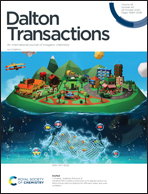Bistable spin-crossover in a new series of [Fe(BPP-R)2]2+ (BPP = 2,6-bis(pyrazol-1-yl)pyridine; R = CN) complexes†
Abstract
Spin-crossover (SCO) active transition metal complexes are a class of switchable molecular materials. Such complexes undergo hysteretic high-spin (HS) to low-spin (LS) transition, and vice versa, rendering them suitable for the development of molecule-based switching and memory elements. Therefore, the search for SCO complexes undergoing abrupt and hysteretic SCO, that is, bistable SCO, is actively carried out by the molecular magnetism community. In this study, we report the bistable SCO characteristics associated with a new series of iron(II) complexes—[Fe(BPP-CN)2](X)2, X = BF4 (1a–d) or ClO4 (2)—belonging to the [Fe(BPP-R)2]2+ (BPP = 2,6-bis(pyrazol-1-yl)pyridine) family of complexes. Among the complexes, the lattice solvent-free complex 2 showed a stable and complete SCO (T1/2 = 241 K) with a thermal hysteresis width (ΔT) of 28 K—the widest ΔT reported so far for a [Fe(BPP-R)2](X)2 family of complexes, showing abrupt SCO. The reproducible and bistable SCO shown by the relatively simple [Fe(BPP-CN)2](X)2 series of molecular complexes is encouraging to pursue [Fe(BPP-R)2]2+ systems for the realization of technologically relevant SCO complexes.
![Graphical abstract: Bistable spin-crossover in a new series of [Fe(BPP-R)2]2+ (BPP = 2,6-bis(pyrazol-1-yl)pyridine; R = CN) complexes](/en/Image/Get?imageInfo.ImageType=GA&imageInfo.ImageIdentifier.ManuscriptID=D0DT02214D&imageInfo.ImageIdentifier.Year=2020)


 Please wait while we load your content...
Please wait while we load your content...